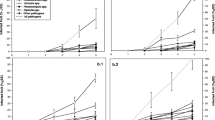Abstract
Litchi fruits are fumigated after harvest with sulfur dioxide (SO2) to prevent their rapid browning. SO2 blocks enzymatic activity but bleaches the fruits and, if this process is followed by dipping the fruit in dilute hydrochloric acid, the appealing red color is regained. Hot water brushing (HWB) is among the alternative methods that were developed to replace the use of SO2. HWB reduced fungal population size on the surface of the fruit peel after treatment but did not eliminate fruit infection after storage. Whereas untreated fruits were infected with a variety of fungal species,Penicillium sp. was the only fungus that developed on the pericarp after storage in fruits that had been dipped in 1.5M HCl. Fruit treated by HWB followed by handling and storage under sterile conditions suffered greater decay than fruit stored under non-sterile conditions but with more ventilation. APenicillium sp. isolated from litchi grew well in liquid medium acidified to the pH range reported for SO2 and HCl-treated litchi fruits. Morphological analysis identified fungal isolates asP. aurantiogriseum. Internal transcribed spacer sequence analysis of five isolates suggested a sequence similarity toP. commune. Our data support the hypothesis that dipping litchi fruit in hydrochloric acid eliminates infection by common opportunistic fungi and selects forPenicillium species that tolerate low pH.
Similar content being viewed by others
References
Fallik, E., Grinberg, S., Alkalai, S., Yekutieli, O., Wiseblum, A., Regev, R.et al. (1999) A unique rapid hot water treatment to improve storage quality of sweet pepper.Postharvest Biol. Technol. 15:25–32.
Fasman, G. (1989) Practical Handbook of Biochemistry and Molecular Biology. CRC Press, Boca Raton, FL, USA.
Frisvad, J.C. and Filtenborg, O. (1993) Saprophytic spoilage association in food mycology with emphasis onPenicillium species.in: Scudamore, K.A. [Ed.] Occurrence and Significance of Mycotoxins. Central Science Laboratory, MAFF, Slough, Berks, UK. pp. 138–145.
Fuchs, Y., Zauberman, G., Ronen, R., Rot, I., Weksler, A. and Akerman, M. (1993) The physiological basis of litchi fruit color retention.Acta Hortic. 343:29–33.
Hall, T.A. (1999) BioEdit: a user-friendly biological sequence alignment editor and analysis program for Windows 95/98/NT.Nucl. Acids Symp. Ser. 41:95–98.
Hofman, C.S. and Winston, F. (1987) A ten-minute DNA preparation from yeast efficiently releases autonomous plasmids for transformation ofEscherichia coli.Gene 57:267–272.
Johnson, G.I., Cooke, A.W., Sardsud, U. and Drew, R. (2000) Postharvest disease control in lychee.Proc. Int. Symp. Tropical Subtropical Fruits (Cairns, NT, Australia), vol. 2, pp. 705–715.
Koffmann, W. and Penrose, L.J. (1987) Fungicides for the control of blue mould (Penicillium spp.) in pome fruits.Sci. Hortic. 31:3–4.
Lichter, A., Dvir, O., Akerman, M., Veisblum, A., Zauberman, G. and Fuchs, Y. (2000) Hot water brushing: an alternative method to SO2 fumigation for color retention of litchi fruits.Postharvest Biol. Technol. 18:235–244.
Mislivec, P.B. and Bruce, V.R. (1976) Comparison of antibiotic-amended potato dextrose agar and acidified potato dextrose agar as growth substrates for fungi.J. Assoc. Off Anal. Chem. 59:720–721.
O’Donnell, K. (1992) Ribosomal DNA internal transcribed spacers are highly divergent in the phytopathogenic ascomyceteFusarium sambucinum (Gibberella pulicaris).Curr. Genet. 22:213–220.
Pielken, P., Stahmann, P. and Sahm, H. (1990) Increase in glucan formation byBotrytis cinerea and analysis of the adherent glucan.Appl. Microbiol. Biotechnol. 33:1–6.
Pitt, J.I. (1993) A modified creatine sucrose medium for differentiation of species inPenicillium subgenusPenicillium.J. Appl. Bacteriol. 75:559–563.
Prince, T.A., Herner, R.C. and Stephens, C.T. (1987) Fungicidal control of infection byPenicillium spp. of precooled tulip bulbs in a modified atmosphere package.Plant Dis. 71:307–311.
Prusky, D., Fuchs, Y., Kobiler, I., Roth, I., Weksler, A., Shalom, Y.et al. (1999) Effect of hot water brushing, prochloraz treatment and waxing on the incidence of black spot decay caused byAlternaria alternata on mango fruits.Postharvest Biol. Technol. 15:165–174.
Skouboe, P., Frisvad, J.C., Taylor, J.W., Lauritsen, D., Boysen, M. and Rossen, L. (1999) Phylogenetic analysis of nucleotide sequences from the ITS region of terverticillatePenicillium species.Mycol. Res. 103:873–881.
Strack, D. and Wray, V. (1989) Anthocyanins.in: Dey, P.M. and Harborne, J.B. [Eds.] Methods in Plant Biochemistry. Academic Press, London, UK. vol. 1, pp. 325–356.
Svendsen, A. and Frisvad, J.C. (1994) A chemotaxonomic study of the terverticillatePenicillia based on high performance liquid chromatography of secondary metabolites.Mycol. Res. 98:1317–1328.
Underhill, S.J.R., Bagshaw, J., Prasad, A., Zauberman, G., Ronen, R. and Fuchs, Y. (1992) The control of lychee (Litchi chinensis Sonn.) postharvest skin browning using sulphur dioxide and low pH.Acta Hortic. 321:731–735.
Underhill, S.J.R. and Critchley, C. (1993) Physiological, biochemical and anatomical changes in lychee (Litchi chinensis Sonn.) pericarp during storage.J. Hortic. Sci. 68:327–335.
Underhill, S.J.R. and Simons, D.H. (1993) Lychee (Litchi chinensis Sonn.) pericarp desiccation and the importance of postharvest micro-cracking.Sci. Hortic. 54:287–294.
Wheeler, K.A., Hurdman, B.F. and Pitt, J.I. (1991) Influence of pH on the growth of some toxigenic species ofAspergillus, Penicillium andFusarium.Int. J. Food Microbiol. 12:141–149.
White, T., Burns, T., Lee, S. and Taylor, J. (1990) Amplification and direct sequencing of fungal ribosomal RNA genes for phylogenetics.in: Innis, M., Gelfand, D., Sninsky, J. and White, T. [Eds.] PCR Protocols: A Guide to Methods and Applications. Academic Press, London, UK. pp. 315–322.
Zauberman, G., Ronen, R., Akerman, M. and Fuchs, Y. (1989) Low pH treatment protects litchi fruit colour.Acta Hortic. 269:309–314.
Zauberman, G., Ronen, R., Akerman, M., Weksler, A., Rot, I. and Fuchs, Y. (1991) Post-harvest retention of the red colour of litchi fruit pericarp.Sci. Hortic. 47:89–97.
Author information
Authors and Affiliations
Corresponding author
Additional information
http://www.phytoparasitica.org posting April 30, 2004.
Rights and permissions
About this article
Cite this article
Lichter, A., Dvir, O., Ackerman, M. et al. Acidified peel of litchi fruits selects for postharvestPenicillium decay. Phytoparasitica 32, 226–236 (2004). https://doi.org/10.1007/BF02979817
Received:
Accepted:
Issue Date:
DOI: https://doi.org/10.1007/BF02979817




